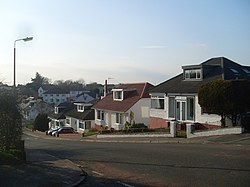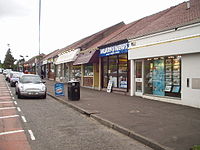Newton Mearns
| Newton Mearns | |
| Renfrewshire | |
|---|---|
 Paidmyre Road | |
| Location | |
| Grid reference: | NS536556 |
| Location: | 55°46’18"N, 4°20’5"W |
| Data | |
| Population: | 22,637 |
| Post town: | Glasgow |
| Postcode: | G77 |
| Dialling code: | 0141 |
| Local Government | |
| Council: | East Renfrewshire |
| Parliamentary constituency: |
East Renfrewshire |
Newton Mearns is a suburban village in Renfrewshire, seven miles south-west of Glasgow City Centre on the main road, the A77 heading across to Ayrshire. It has a population of approximately 22,636. The village has become part of the conurbation spreading out from Glasgow.
The name of the village derives from being a new town of the Mearns (the latter a term from court Gaelic a' Mhaoirne, meaning a stewartry).
Contents
History
Until the 20th century, the land around Newton Mearns was primarily agricultural. Ownership passed from the Pollocks (whose name is perpetuated in the nearby Glasgow housing estate of Pollok) to the Maxwells of Caerlaverock around 1300. It then passed to the Maxwells of Nether Pollok in 1648 and then the Stewarts of Blackhall in 1660.
A new turnpike road from Eastwood Toll, now the main Ayr Road, was constructed in 1832.[1] The 1893 'Ordnance Gazetteer of Scotland' describes Newton Mearns as: "pleasantly situated on a rising ground 410 feet above sea-level"; a "single street on the Glasgow and Kilmarnock highroad"[2]
Notwithstanding its diminutive nature in the 1880s, Newton Mearns was a 'burgh of barony' which bestowed the right to hold a weekly market and two annual fairs.
By the end of the 18th century quarrying had developed and more importantly numerous textile mills and finishing works became established availing themselves of the numerous rivers and lochs for water supply. From the early 20th century, with the introduction of improved roads and railways to the area, it gradually became a growing commuter suburb of Glasgow. In the 1930s, between speculative and local authority housing ventures, a further 6,000 houses were added to the area and after a lull during the war years, in the 1950s, house building began again in earnest. The old core village suffered horrible neglect during and after the Second World War and was all but derelict by the 1960s. It was purchased and turned into a shopping centre which was later to become 'The Avenue at Mearns' in 1991.[2]
Historical buildings in the area include the 15th century Mearns Castle,[3] Greenbank House, owned by the National Trust for Scotland, and the 1813 Mearns Kirk.[1]
Economy
Newton Mearns is a primarily a residential area, with most of its inhabitants travelling by car or public transport to Glasgow for employment and shopping. However, there are a number of small businesses in the area, as well as an indoor shopping centre.
The Avenue Shopping Centre is the main large retail centre in Newton Mearns. It comprises a total of 44 stores, currently including two supermarkets, five banks, nine clothing stores, food shops, restaurants and library. The line of the main mall at the Avenue runs the course of the old Mearns Main Street. There are also shopping units and restaurants at Broom on the Ayr Road, shopping units and restaurants at Broomburn on the Mearns Road, and shopping units and restaurants at Crookfur on Harvie Avenue. The newly constructed Greenlaw Village close to the M77 at Crookfur Road also has a supermarket, a hotel, smaller shops and a number of restaurants.[4]
Farming continues to be important to the south of Mearns Cross and stretching to Fenwick and Eaglesham Moors. A major Bleach Works and textile finishing centre[5] was built at Netherplace, the site of which is still visible from the M77 motorway.
Churches
Newton Mearns has numerous places of worship:
- Church of Scotland: Four churches
- Baptist
- Roman Catholic
Also two Jewish synagogues and a community Muslim hall.
Leisure
Newton Mearns contains a number of parks, including Broomburn Park, Mearns Park, Crookfur Park & Parklands Country Club and nearby Rouken Glen Park with its boating pond, gardens and leisure facilities. There are numerous golf clubs, a golf academy, a tennis club, bowling club and rugby club. A public swimming pool and leisure centre is located at Eastwood Park in nearby Giffnock, and the swimming pool and sports centre at Eastwood High School is open to the public. Between Mearns and Barrhead lie the former reservoirs and water runs of the Gorbals Water Works pioneered in the 19th century, before the building of the Loch Katrine Water Works. The reservoirs and surrounding parklands now form the Dams to Darnley Country Park.
- Football: Newton Mearns Rovers AFC, established in 1962
In literature and popular fiction
Newton Mearns was briefly mentioned in John McGrath's play Little Red Hen (1975, first publ. London: Pluto 1977, p. 34).
More recently, the town appeared as the setting for the thriller novel Aztec Love Song (Weathervane Press 2009, ISBN 978-0-9562193-2-9) by Marty Ross, a Scottish author best known for his BBC radio plays, who grew up in the town and studied at Mearns Castle High School.
Pictures
Outside links
References
- ↑ 1.0 1.1 "History". Mearnsparishkirk.co.uk. http://www.mearnsparishkirk.co.uk/html/history.html. Retrieved 2009-06-16.
- ↑ 2.0 2.1 David Kidd, Anne Loudon (2001). Old Newton Mearns. Catrine, Ayrshire: Stenlake Publishing. p. 3. ISBN 9781840331783. http://www.stenlake.co.uk/books/view_book.php?ref=240.
- ↑ "Scottish Castles Photo Library - Mearns Castle, East Renfrewshire". Rampantscotland.com. http://www.rampantscotland.com/castles/blcastles_mearns.htm. Retrieved 2009-06-16.
- ↑ Newton Mearns Through Time by Graeme Smith and Anne Robertson, published by Amberley Publishing, 2014
- ↑ CANMORE (RCAHMS) record of Netherplace Bleachworks


